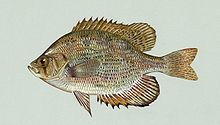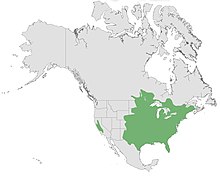| Sunfish Temporal range: Late Eocene to Recent
| |
|---|---|

| |
| Flier (Centrarchus macropterus) | |
| Scientific classification | |
| Domain: | Eukaryota |
| Kingdom: | Animalia |
| Phylum: | Chordata |
| Class: | Actinopterygii |
| Order: | Centrarchiformes |
| Suborder: | Centrarchoidei |
| Family: | Centrarchidae Bleeker, 1859[1] |
| Type species | |
| Centrarchus macropterus Lacépède, 1801
| |
| Subfamilies | |
|
See text | |

| |
| Centrarchidae native range | |
Centrarchidae, better known as sunfishes, is a family of freshwater ray-finned fish belonging to the order Centrarchiformes, native only to North America. There are eight universally included genera within the centrarchid family: Lepomis (true sunfishes), Micropterus (black basses), Pomoxis (crappies), Enneacanthus (banded sunfishes), Centrarchus (type genus, consisting solely of the flier C. macropterus), Archoplites (Sacramento perch), Ambloplites (rock basses), and Acantharchus (mud sunfish).[2] A genetic study in 2012 suggests that the highly distinct pygmy sunfishes of the genus Elassoma are also centrarchids.[3][4]
The centrarchid family comprises 38 identified species,[2] 34 of which are extant.[5] It includes many popular game fishes familiar to North American anglers, such as the largemouth bass, rock bass, bluegill, pumpkinseed, green sunfish and crappies. Most sunfish are highly valued panfish for sport fishing, and have been introduced in many areas outside their native ranges, sometimes becoming invasive species. While edible, they are not commercially marketed as food fish.
- ^ Richard van der Laan; William N. Eschmeyer & Ronald Fricke (2014). "Family-group names of Recent fishes". Zootaxa. 3882 (2): 001–230. doi:10.11646/zootaxa.3882.1.1. PMID 25543675.
- ^ a b Smith, Andrew J.; Nelson-Maney, Nathan; Parsons, Kevin J.; Cooper, W. James; Albertson, R. Craig (2015-09-01). "Body Shape Evolution in Sunfishes: Divergent Paths to Accelerated Rates of Speciation in the Centrarchidae". Evolutionary Biology. 42 (3): 283–295. Bibcode:2015EvBio..42..283S. doi:10.1007/s11692-015-9322-y. ISSN 0071-3260. S2CID 17580461.
- ^ Thomas J. Near; Michael Sandel; Kristen L. Kuhn; Peter J. Unmack; Peter C. Wainwright; Wm. Leo Smith (2012). "Nuclear gene-inferred phylogenies resolve the relationships of the enigmatic Pygmy Sunfishes, Elassoma (Teleostei: Percomorpha)". Molecular Phylogenetics and Evolution. doi:10.1016/j.ympev.2012.01.011.
- ^ Jörg Bohlen and Arne Nolte (Fall 2012). Rudolf G. Arndt (ed.). "Elassoma zonatum, E. okefenokee, and E. evergladei:Habitats and Comparative Observations" (PDF). American Currents. Vol. 37, no. 4. NANFA. pp. 8–17.
- ^ Near, Thomas J.; Kassler, Todd W.; Koppelman, Jeffrey B.; Dillman, Casey B.; Philipp, David P.; Orti, G. (2003-07-01). "Speciation in North American black basses, micropterus (actinopterygii: centrarchidae)". Evolution. 57 (7): 1610–1621. doi:10.1554/02-295. ISSN 0014-3820. PMID 12940365. S2CID 198155858.